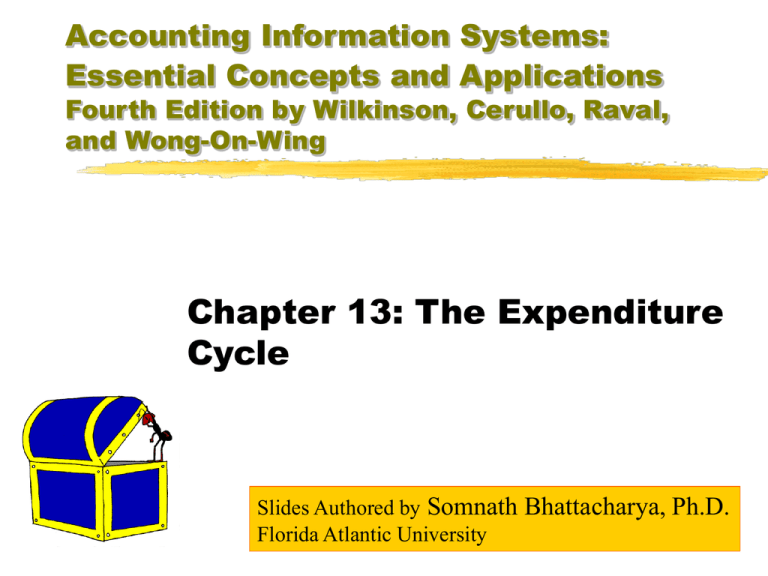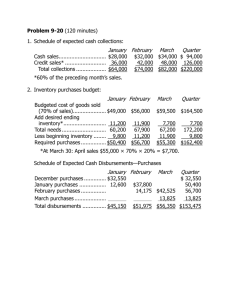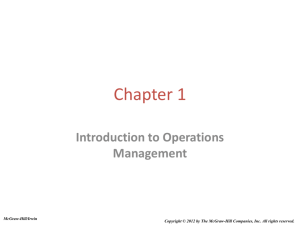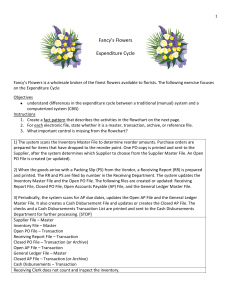
Accounting Information Systems:
Essential Concepts and Applications
Fourth Edition by Wilkinson, Cerullo, Raval,
and Wong-On-Wing
Chapter 13: The Expenditure
Cycle
Slides Authored by Somnath Bhattacharya, Ph.D.
Florida Atlantic University
Introduction
Because this cycle involves
the outflow of cash, it is the
counterpoint to the revenue cycle
Expenditure cycles tend to be similar for
all types of firms - merchandising to
manufacturing to services
Two subsystems include:
The purchases processing system
The cash disbursements processing system
Objectives of the Cycle
To ensure that all goods and services are ordered as
needed
To receive all ordered goods and verify that they are in
good condition
To safeguard goods until needed
To ensure that invoices pertaining to goods and services
are valid and correct
To record and classify the expenditures promptly and
accurately
To post obligations and cash disbursements to proper
suppliers’ accounts in the accounts payable ledger
To ensure that all cash disbursements are related to
authorized expenditures
To record and classify cash disbursements promptly and
accurately
Relationships of Organizational Units
to Expenditure Cycle Functions
VP
Logistics
Purchasing
Receiving
Inventory
Budgeting
& Cash
Planning
Recognize need
for goods &
services
Figure 13-1
Place
Order
VP
Finance
Production
Inventory
Control
Receive
and Store
goods
Accounts
Payable
Cash
Disbursements
Determine validity
of payment
obligation
Maintain
Accounts
Payable
General
Ledger
Make Cash
Disbursements
Post Transactions
& Prepare Financial
Reports
Documents Pertaining to
the Expenditure Cycle
Purchase Requisition
Purchase Order
Receiving Report
Supplier’s (Vendor’s) Invoice
Disbursement Voucher
Disbursement Check
Debit Memorandum
New Supplier Form
Request for Proposal
Figure 13-2
Purchasing & Payables
Processing System
Purchases
Request for Proposals
Inventory Status Reports
Receiving
Receiving Report
Payables
Disbursements Voucher File
Preparing Analyses & Reports
Handling Purchase Returns & Allowances
Debit Memorandum
Cash Disbursements
Processing System
Processing Petty Cash disbursements
Imprest System
Disbursing cash for
miscellaneous purposes
Managerial Decisions Pertaining to
the Expenditure Cycle - I
Inventory Decisions
What levels of merchandise inventory should
be stocked?
When should particular inventory be
reordered?
What quantities of particular inventory items
should be reordered?
When should long term purchase contracts
be obtained for particular inventory items?
Figure 13-11
Managerial Decisions Pertaining to
the Expenditure Cycle - II
Inventory Decisions (Continued)
Which suppliers should be established as long-term
sources of merchandise and supplies?
From which suppliers should particular inventory
items be ordered?
What procedures should be followed in receiving and
storing merchandise inventory?
What organizational units are to be included in the
inventory management and logistics function?
What logistics plans and budgets are to be
established for the coming year?
Figure 13-11 Continued
Managerial Decisions Pertaining to
the Expenditure Cycle - III
Financial Decisions
What policies concerning purchase terms and
discounts should be established?
What level of service should departments be
allowed to inquire?
What accounts payable records are to be
maintained concerning amounts owed to
suppliers?
What financial plans and budgets are to be
established for the coming year?
What sources of funds are to be employed?
Figure 13-11 Continued
Operational Listings &
Reports
Voucher Register
Check Register
Open Purchase Order Report
Open Invoices Report
Inventory Status Report
Overdue Deliveries Report
Scheduled Managerial
Reports
A Payables Aging Report
Purchase Analyses
Vendor Performance Report
Cash-flow Statement
Critical Factors Report
Data Management: File
Oriented Approach
Master Files
Supplier/Vendor Master File
Accounts Payable Master File
Merchandise Inventory Master File
Transaction & Open Document Files
Purchase Order File
Open Purchase Order File
Supplier’s Invoice File
Open Vouchers File
Cash Disbursements File
Other Files
A Supplier Reference & History File
A Buyer File
An Accounts Payable Detail File
Figure 13-16
A Layout of a Supplier
(Accounts Payable) Record
Supplier Supplier Mailing
Account
Number
Figure 13-17
Name Address
Phone Credit Year-to-date Year-to-date Current
Number Terms Purchases
in total
Payments
in total
Account
Balance
Control Objectives - I
All purchases are authorized on a timely basis
when needed and are based on EOQ
calculations
All received goods are verified to determine that
the quantities agree with those ordered and that
they are in good condition
All services are authorized before being
performed and are monitored to determine that
they are properly performed
Control Objectives - II
All suppliers’ invoices are verified on a timely
basis and conform with goods received or
services performed
All available purchase discounts are identified,
so that they may be taken if economical to do
so
All purchase returns and allowances are
authorized and accurately recorded and based
on actual return of goods
Control Objectives - III
All cash disbursements are recorded completely
and accurately
All credit purchases and cash disbursements
transactions are posted to proper suppliers’
accounts in the accounts payable ledger
All accounting records and merchandise
inventory are safeguarded
Risk Exposures Within the
Expenditure Cycle - I
Risk
Exposure(s)
1) Orders placed for
unneeded goods or
more goods than
needed
Receipt of uncoded
goods
3) No receipt of ordered
goods
4) Fraudulent placement
of orders by buyers with
suppliers to whom they
have personal or
financial attachments
1) Excessive inventory
and storage costs
Figure 13-20
2) Excessive inventory
and storage costs
3) Losses due to
stockouts
4) Possibility of inferior
or overpriced goods or
services
Risk Exposures Within the
Expenditure Cycle - II
Risk
Exposure(s)
5) Creation of fictitious invoices
and other purchasing
documents
6) Lack of vigilance in writing
down inventory that is aged or
damaged
7) Omission of liabilities, such
as material contingencies
5) Overstatement of inventory;
losses of cash disbursed
8) Overcharges (with respect
either to unit prices or to
quantities) by suppliers for
goods delivered
8) Excessive purchasing costs
Figure 13-20 Continued
6) Overstatement of inventory
7) Understatement of liabilities
Risk Exposures Within the
Expenditure Cycle - III
Risk
Exposure(s)
9) Damage to goods
enroute to the acquiring
firm
10) Errors by suppliers
in computing amounts
or invoices
11) Erroneous or
omitted postings of
purchases or purchase
returns to supplier’s
accounts payable
records
12) Errors in charging
transaction amounts to
purchases and expense
accounts
9) Possibility of inferior
goods for use or sale
Figure 13-20 Continued
10) Possibility of
overpayment for goods
received
11) Incorrect balances in
accounts payable and
general ledger account
records
12) Incorrect levels
(either high or low) for
purchases and expense
accounts
Risk Exposures Within the
Expenditure Cycle - IV
Risk
Exposure(s)
13) Lost purchase
13) Excessive purchasing
discounts due to late
costs
payments
14) Duplicate payments of 14) Excessive purchasing
invoices from suppliers
costs
15) Incorrect
15) Loss of cash and
disbursements of cash,
excessive costs for goods
either to improper or
and services
fictitious parties or for
greater amounts than
approved
Figure 13-20 Continued
Risk Exposures Within the
Expenditure Cycle - V
Risk
Exposure(s)
16) Improper
disbursement of cash for
goods or services not
received
17) Theft of scrap
proceeds
18) Disbursement of
checks payable to
employees for
unauthorized expenses
or fraudulent claims
19) Fraudulent alteration
and cashing of checks
by employees
20) Kiting of checks by
employees
16) Excessive costs for
goods or services
Figure 13-20 Continued
17) Loss of cash
18) Loss of cash
19) Loss of cash
20) Overstatement of
back balances; possible
losses of deposited cash
Risk Exposures Within the
Expenditure Cycle - VI
Risk
Exposure(s)
21) Accessing of supplier
records by unauthorized
persons
21) Loss of security over
such records, with possible
detrimental use made of
data accessed
22) Loss of or damage to
assets, including possible
loss of data needed to
monitor payments of
amounts due to suppliers
within discount periods
23) Loss of data or unreliable
data resulting in inaccurate
purchase orders
24) Excessive inventory and
storage costs
22) Involvement of cash,
merchandise inventory, and
accounts payable record in
natural or human-made
disasters
23) Interception of data
transmitted via the Web
24) Unauthorized purchase
requisitions and purchase
orders initiated via the Web
Figure 13-20 Continued
Risk Exposures Within the
Expenditure Cycle - VII
Risk
Exposure(s)
25) Unauthorized
viewing and alteration of
a company’s purchase
records via the Web
26) Breakdown of the
Web server due to
unexpected events
25) Loss of security over
data which can be used
to the detriment of the
company
26) Loss of data and
delay in processing
purchase orders
Figure 13-20 Continued
General Controls - I
Organizational Controls
Documentation Controls
Asset Accountability Controls
Management Practices Controls
Training & Bonding of employees
Systems development & changes subject to
prior approvals, testing, and sign-off
Audits on purchases and cash disbursements
Periodic review and analyses of account
activity and computer-approved transactions
General Controls - II
Data Center Operations Controls
Authorization Controls
Access Controls
Assigned passwords required in order to access accounts
payable and other supplier-related files
Terminals restricted in their functions with respect to purchases
and cash disbursement transactions
Logging of all purchases and cash disbursement transactions
upon their entry into the system
Frequent dumping of accounts payable and merchandise
inventory master files onto magnetic tape backup
Physically protected warehouses
Logs that monitor all accesses of data stored in files
Application Controls Pertaining to the
Expenditure Cycle: Input Controls
1) Prepare pre-numbered and well-designed
documents relating to purchases, receiving,
payables, and cash disbursements
2) Validate data on purchase orders and
receiving reports and invoices as the data are
prepared and entered for processing
3) Correct errors that are detected during data
entry and before the data are posted to the
supplier and inventory records
4) Pre-compute batch control totals relating to
key data on suppliers’ invoices and vouchers
due for payment
Figure 13-21
Application Controls Pertaining to the
Expenditure Cycle: Processing Controls
1) Issue purchase requisitions, purchase orders,
disbursement vouchers, checks, and debit
memoranda on the basis of valid authorizations
2) verify all data elements and computations on
purchase requisitions and on purchase orders
3) Vouch all data elements and computations on
suppliers’ invoices
4) Monitor all open transactions, such as partial
deliveries and rejected goods
5) issue debit memoranda only on the basis of
prior approval of the purchasing or other
appropriate manager
Figure 13-21 Continued
Application Controls Pertaining to the
Expenditure Cycle: Processing Controls
6) Reconcile amounts in the accounts payable
subsidiary ledger and expense ledgers with
control accounts in the general ledger
7) Verify that total postings to the accounts
payable file accounts agree with the total
postings to the general ledger accounts
8) Monitor discount terms relating to payment
9) review evidence supporting the validity of
expenditures and the correctness of amounts
prior to the signing of checks
10) use check protectors to protect the amounts
on checks against alteration before the checks
are presented to be signed
Figure 13-21 Continued
Application Controls Pertaining to the
Expenditure Cycle: Processing Controls
11) Require that checks over a specified amount
be countersigned by a second manager
12) Verify all inventories on hand by physical
counts once yearly, and reconcile the counted
quantities with the quantities shown in the
inventory records
13) Use imprest systems for disbursing currency
from petty-cash funds, with the funds being
subject to surprise counts by internal auditors or
a designated manager
Figure 13-21 Continued
Application Controls Pertaining to the
Expenditure Cycle: Processing Controls
14) Establish purchasing policies that require
competitive bidding for large and/or non-routine
purchases and that prohibit conflicts of interest
15) Correct errors that are made during
processing steps, usually by reversing erroneous
postings to accounts and entering correct data
Figure 13-21 Continued
Application Controls Pertaining to the
Expenditure Cycle: Output Controls
1) establish clear-cut receiving and payables
cut-off policies, so that inventories and accounts
payable are fairly valued at the end of each
accounting period
2) Establish budgetary control over purchases,
with periodic reviews of actual purchase costs
and such key factors as inventory turnover rates
3) Compare monthly statements from suppliers
with the balances appearing in the suppliers’
accounts in accounts payable
Figure 13-21 Continued
Application Controls Pertaining to the
Expenditure Cycle: Output Controls
4) File copies of all documents pertaining to
purchases and cash disbursements by number;
including voided documents such as checks
5) Print transaction listings in order to provide
an adequate audit trail
Figure 13-21 Continued
Programmed Edit Checks Useful in validating
Transaction Data in the Expenditure Cycle
Validity check
Self-checking digit
Field check
Limit check
Range check
Relationship check
Sign check
Completeness check*
Echo checks*
*
= applicable only to online systems
Web Security Procedures
Authentication
Authorization
Accountability
Data Transmission
Disaster Contingency & Recovery Plan
Accounting Information Systems:
Essential Concepts and Applications
Fourth Edition by Wilkinson, Cerullo,
Raval, and Wong-On-Wing
Copyright © 2000 John Wiley & Sons, Inc. All rights reserved.
Reproduction or translation of this work beyond that permitted in
Section 117 of the 1976 United States Copyright Act without the express
written permission of the copyright owner is unlawful. Request for
further information should be addressed to the Permissions Department,
John Wiley & Sons, Inc. The purchaser may make back-up copies for
his/her own use only and not for distribution or resale. The publisher
assumes no responsibility for errors, omissions, or damages, caused by
the use of these programs or from the use of the information contained
herein.






